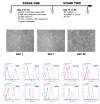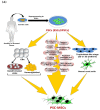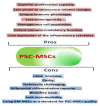Production of Mesenchymal Stem Cells Through Stem Cell Reprogramming
- PMID: 31003536
- PMCID: PMC6514654
- DOI: 10.3390/ijms20081922
Production of Mesenchymal Stem Cells Through Stem Cell Reprogramming
Abstract
Mesenchymal stem cells (MSCs) possess a broad spectrum of therapeutic applications and have been used in clinical trials. MSCs are mainly retrieved from adult or fetal tissues. However, there are many obstacles with the use of tissue-derived MSCs, such as shortages of tissue sources, difficult and invasive retrieval methods, cell population heterogeneity, low purity, cell senescence, and loss of pluripotency and proliferative capacities over continuous passages. Therefore, other methods to obtain high-quality MSCs need to be developed to overcome the limitations of tissue-derived MSCs. Pluripotent stem cells (PSCs), including embryonic stem cells (ESCs) and induced pluripotent stem cells (iPSCs), are considered potent sources for the derivation of MSCs. PSC-derived MSCs (PSC-MSCs) may surpass tissue-derived MSCs in proliferation capacity, immunomodulatory activity, and in vivo therapeutic applications. In this review, we will discuss basic as well as recent protocols for the production of PSC-MSCs and their in vitro and in vivo therapeutic efficacies. A better understanding of the current advances in the production of PSC-MSCs will inspire scientists to devise more efficient differentiation methods that will be a breakthrough in the clinical application of PSC-MSCs.
Keywords: differentiation methods; in vitro and in vivo therapeutic efficacies; mesenchymal stem cells (MSCs); pluripotent stem cells (PSCs); pluripotent stem cells-derived mesenchymal stem cells (PSC-MSCs); tissue-derived mesenchymal stem cells.
Conflict of interest statement
The authors declare no conflict of interest. The funders had no role in the design of the study; in the collection, analyses, or interpretation of data; in the writing of the manuscript, or in the decision to publish the results
Figures










References
Publication types
MeSH terms
LinkOut - more resources
Full Text Sources
Other Literature Sources

